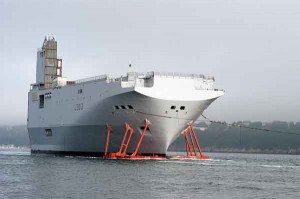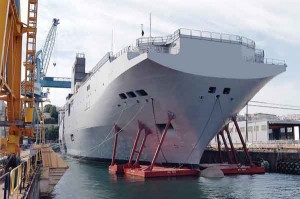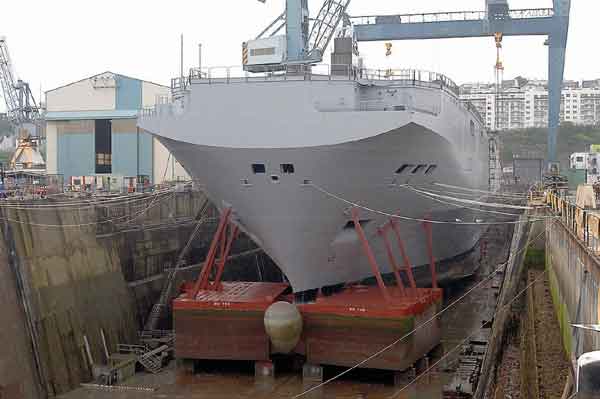International rules that have evolved from the main ‘IMO Conventions and Recommendations’ as well as the ‘EU National Rules’ are not mandatory for warships. Nonetheless, the French Navy decided to adopt a large part of these requirements for its own ships; in particular, for ships conforming to SOLAS and MARPOL regulations.
For this reason, the French Navy chose to take into account various conditions, with regard to its own military requirements, together with the feed back received from naval ships in service.
Needless to say, such a deliberate choice is covered with a formal decision from the Navy’s Chief of Staff: this decision takes the shape of formal written regulations, specifying the universal requirements for the construction of surface warships, including their sea-worthiness.
Based on these requirements, the Technical Department of the Defence Services created an entirely new concept relating to technical regulations for ship construction. The most important regulation pertains to the Classification Society Rules, drawn up on the same lines as those for merchant ships. If necessary, complementary technical rules may be added, concerning storage and handling of ammunition, aviation on board ships, procedure for handling NBC threats, electromagnetic compatibility, special sick-berth fittings, and rules associated with ship’s stealth profile, etc.
 Formulation of technical regulations, the core of which are the ‘Classification Rules’, facilitates better relationship with civilian ship-builders. It also enables better cooperation between navies. Moreover, it is helpful when making design choices for selecting ‘off-the-shelf’ equipment; this technique is much less expensive than the individual designs made by the state shipyards for the Navy.
Formulation of technical regulations, the core of which are the ‘Classification Rules’, facilitates better relationship with civilian ship-builders. It also enables better cooperation between navies. Moreover, it is helpful when making design choices for selecting ‘off-the-shelf’ equipment; this technique is much less expensive than the individual designs made by the state shipyards for the Navy.
The French Navy is actually a trailblazer among the major navies: it is the first Navy to implement the same practices for Warship Classification as those for merchant ships.
The ‘Mistral’ class vessels are the first combat vessels to be compliant with SOLAS and MARPOL (ship cleanliness) rules.
Finally, in several aspects, the standard of warship-building is higher than the one in the civilian shipyards: that should be quite natural, considering it relates to a combat ship. But, in many ways, the French Navy thinks that choosing adapted civilian rules is a great advance.
By adopting this novel practice, the French Navy gave the warship-building industry a new impetus. It is coming closer to the best civilian practices in the field of ship construction, while at the same time adding crucial value for a combatant ship—the ideal choice of using optimum military hardware plus minimum crew size!
Classification of Warships
In the year 2000, the French Navy decided to have its new surface ship-building programs covered by the classification process.
 This decision was based upon the availability of Classification Rules for Warships, developed by Bureau Veritas in cooperation with the French Navy Headquarters, the French procurement agencies, and the French naval shipyard (DCNS).
This decision was based upon the availability of Classification Rules for Warships, developed by Bureau Veritas in cooperation with the French Navy Headquarters, the French procurement agencies, and the French naval shipyard (DCNS).
A working group of ‘Bureau Veritas’ was set up to develop such rules, under the supervision of a Steering Committee composed of representatives from ‘Bureau Veritas’, the naval ship-contractor and the technical body DGA, the French Navy Headquarters, the naval shipyard DCN and a major civil shipyard (Alstom Chantiers de l’Atlantique.)
A co-operative organisation was set up with 12 specialised working groups each dealing with different technical aspects. Specialists of different companies and organisations were involved in each of the above groups to select the existing merchant ship-building rules to be retained in toto, deleted, or adapted for warship construction in disciplines such as Hull design, construction and stability, main propulsion, electric power generation, automation, as well as special shipyard materials, and armour plating for warships.
Intense activity for almost three years resulted in 16 meetings of the Steering Committee and each 15 meetings of each working group.
The process involved a review of the new version of ‘BV Rules 2000 for Merchant Ships’: validate the rules to be retained in toto, identify and delete the rules not relevant for warships, and adapt rules for the military scenario.
An initial version of ‘BV Naval Rules’ was released in 2002 (in French), , then in 2003 (in English). The latest update, dated September 2006, includes the lessons learnt from successive reviews.
Principles of Classification
The classification of ships is achieved by ensuring conformity to the appropriate rules of the classification society, in this case, the Naval regulations.
Classification is carried out in a three-step process:
- Design approval: Detailed approval of all design aspects of the ship’s Hull, generation and distribution of electric power, main propulsion, ship’s stability and safety including structural stability curves, fire protection and fire-fighting devices, escape routes and evacuation, etc.
- Certification of materials and safety-related equipment at the Makers’ works: Main and auxiliary Engines, propulsion systems, insulated bulkheads, fire-fighting equipment, fire detection, electrical cables-Switchboards-Junction Boxes…
- Construction Survey: It includes a Preliminary Meeting, approval of internal shipyard fabrication and quality plan, approval of welders and of welding procedures, survey at the yard’s premises, attendance to tests, Harbour and Sea Trials, issue of Classification Certificates, etc.





